Open-Source Software and Localization
An introduction to OSS and its impact on the language industry.
Published March 2005 in Multilingual
Computing & Technology.
By Frank
Bergmann
Open-source software (OSS) is already part of the mainstream information
technology. Most medium and large companies in the world are already
using it in some way or another. Apart from being cheaper, OSS is
considered to be more secure and more flexible than its commercial
counterparts. Corporate customers love the independence from a particular
software vendor and the possibility to customize the software to
the company’s needs, making it difficult for closed-software
providers to compete with OSS.
However, OSS just recently became the candidate for “the
next big thing” in the IT industry, the driver of a major
wave of change that might radically alter the market forces, comparable
only to the introduction of the PC or the Internet. But this time,
the revolution is not that much about technology, but about the
business models of the IT companies. This article explores some
of these potential changes and how they might affect localization
customers and providers.
The Rise of Open-Source Software
Before starting to discuss the impact of OSS on the software localization
process, we need to understand how OSS went from its roots to conquest
the corporate world. OSS was “born” in the 1960’s
and 1970’s in the university and research environment [1].
Researchers started to use computer programs for their activities
and, working in a non-competitive environment, began to share the
resulting computer programs amongst them just like they did with
their research findings. These groups of collaborating software
developers are today known as “open-source developer communities”.
However, these early OS developers wanted to make sure that they
received the fame and reputation as the authors of the code, similar
to the scientific system of quoting research publications. So the
“GNU Public License” (GPL) software license emerged
[2], implementing the scientific citation rule in the domain of
intellectual property rights. The GPL advocates that everybody can
use, modify and redistribute “GPLed” software, provided
that the initial authorship information is maintained. However,
modifications and additions to GPLed software are GPLed again, creating
what is known today as a “viral effect”. The GPL “infects”
other code when combined, so that the body of OSS grows and grows
ever since then.
OSS Leaves the Academic Niche
A major breakthrough for OSS came with the advent of the dot.com
boom. The Internet initially developed in research institutions,
and most of it is based on OSS. Also, the first industry-strength
versions of Linux appeared during this time, creating an ideal environment
for the young entrepreneurs. So it is no surprise that many startups
during the dot.com boom used the readily available OSS as a base
for their business. Google, eBay, Yahoo and Amazon are all still
using this infrastructure.
Another breakthrough came with the need of these first OSS companies
to support and maintain their software. So they started to outsource
these services to other companies, effectively creating a market
for the first Linux distribution companies such as RedHat and SuSE.
The business model of these companies is based on selling professional
services around the free OSS product.
The support work of these companies contributed to the quality
of the OSS, lifting it into the same quality dimension as its closed-source
competitors. And the availability of professional services made
OSS an attractive choice for companies of all sizes who had to slash
costs after the dot.com bust.
Finally, another important wave of change is just starting: OSS-based
companies have started to offer “mixed-source” [3] software,
extending OSS with proprietary functionality. These companies use
OSS merely as a base, while providing the same service level to
their customers as their closed-source competitors. As a result,
the marketing mussels of these companies now push OSS. The most
famous example in this field are IBM and Novell with their Linux
strategy and Sun Microsystems with its StarOffice/OpenOffice and
Java Desktop products.
The “Pure OSS” L10N Market
But how is the l10n market going to look like that is created
by these new players? To answer this question we are going to differentiate
between “pure” OSS and “mixed-source”.
Looking at the l10n needs of “pure” open-source developer
communities, we may find that these communities are not very attractive
customers, because they do not earn any revenues from their software
products. Instead, they have to rely on volunteers from within the
OS community in the same way as they rely on volunteers for software
development. The quality of these translations is in general not
as high as in closed-source software. However, this situation actually
stimulates unhappy users to participate in the OS project and to
contribute an improved translation.
However, there are some notable exceptions to this system, namely
when OSS customers are willing to pay for a professional l10n. In
particular, this is the case in the public sector where government
agencies around the world seem to favor OSS over proprietary software
[4,5]. There are bodies in the European Union facilitating these
efforts [6], so we may expect an increasing standardization in the
products being employed and a need for professional l10n.
The Mixed-Source L10N Market
The situation is more promising in the realm of mixed-source companies
who somehow combine OSS with proprietary software in order to deliver
a professional product to the market. These companies need to provide
high-quality l10ns and have a budget and an organization in place
to provide this service. For instance, Melissa Biggs from Sun Microsystems
Globalization Engineering Group reported to us in a telephone interview
that the “l10n processes for OpenOffice are basically the
same as for other Sun products”.
However, mixed-source companies can also rely on the l10n volunteers
from the OS community, depending on quality and completeness requirements
and the available budget. The Sun G11N Engineering groups for instance
has started a “Pilot Process” to “improve communication”
between the Sun g11n group and the OS community [7].
OSS L10N Technology
We are now turning our focus towards the technical resources and
skills that a l10n company needs in order to enter the OSS l10n
market. To shed some light in this area, we present you below the
l10n architectures of three very different OSS applications: Linux
is an operating system, OpenOffice is a desktop application similar
to Microsoft Office and ]project-open[ is a web-based application.
Also, the three systems are very different with respect to the
l10n organization, with Linux being a “pure” OSS and
localization by community volunteers, OpenOffice l10n management
split depending on the language (Sun manages 10 languages, the OS
community the rest) and ]project-open[ l10n split depending on application
modules.
Common to all three systems is that their l10n processes are considerably
different from the ones used for standard Windows applications.
Every system comes with its own set of l10n tools and philosophy,
requiring a considerable learning effort from a potential l10n provider.
 Frank
Bergmann is a l10n consultant and
Frank
Bergmann is a l10n consultant and
founder of ]project-open[. He can be reached at
frank.bergmann@project_dash_open.com |
Conclusion
OSS l10n is probably not an interesting mainstream l10n market
yet, and pure OSS will probably never be. However, the overall share
of OSS is growing fast and mixed-source l10n will become an interesting
market in the close future.
Companies who are determined to enter this market will need considerable
in-house technology resources. Getting involved in a particular
OSS project may be a good start to investigating the new terrain.
Case Studies
Below we present three different open-source software packages
and compare the technical and linguistic aspects of their localization.
 "Tux", the Linux Penguin. Linux
is probably
"Tux", the Linux Penguin. Linux
is probably
the most well known open-source product. |
Linux Localization
Linux [8] is probably the most well known open-source product.
Linux servers represent 15.6% of 2003 overall server market with
growth rates of 40% annually (IDC). Linux is currently localized
into some 73 languages.
The Linux l10n software architecture is based on the GNU “gettext”
tool suite [9], together with a range of gettext compatible translator’s
tools such as KBabel [10], PO-Edit, GTranslator and others. Gettext
allows identifying translatable strings in the Linux source code
and extracting them into a format suitable for KBabel and the other
l10n tools. This l10n architecture is shared by the majority of
open-source projects, forming the de-facto standard in open-source
related l10n.
The quality requirements for the Linux operating system and server
software in general are considerably low, because most Linux users
are system administrators with a high level of English. Also, users
of open-source software typically don’t expect a very high
level of translation quality and completeness.
The l10n “market” of gettext is organized as groups
of volunteers from the target language countries. Most of these
volunteers are university students who are using the software for
their own purposes.
OpenOffice Localization
OpenOffice [11] is an open-source office suite similar to Microsoft
Office, including applications such as word processor, spreadsheet,
presentations and drawing. OpenOffice has been localized into 25
languages and has been downloaded by some 16 million+ users. OpenOffice
is an open-source variant of Sun Microsystems StarOffice product
and localized under the organizational umbrella of Sun.
The OpenOffice l10n architecture is similar to the GNU gettext
architecture explained above. A specific localization tool called
“localize.pl” [12] is used to extracts translatable
strings from the source code. This list can be converted into the
gettext format suitable for KBabel or into a format suitable for
Trados and other translation memories.
The l10n quality requirements for OpenOffice depend on each language.
OpenOffice inherits the professional l10n of the 10 languages under
the responsibility of Sun’s G11N Engineering Group (FIGS,
Swedish, Brazilian Portuguese, Japanese, Korean, Simplified and
Traditiona Chinese) [7]. Several open-source groups consisting of
volunteers handle the translation of the remaining languages.
OpenOffice is currently developing a “Localization Pilot
Process” [7] to involve the open-source community into the
l10n process, probably with the goal of cutting costs. This process
will reduce the need for professional l10n outsourcing if successful.
![]project-translation[ [12] is a web-based project management and workflow system specifically designed for translation and localization companies.](../../images/logos/logo.project-open.white.gif) ]project-translation[ is a web-based
]project-translation[ is a web-based
project management and workflow
system specifically designed for
translation and localization companies. |
]project-translation[ Localization
]project-translation[ [12] is a web-based project management and
workflow system specifically designed for translation and localization
companies. ]project-translation[ is “mixed source” software
because most of its modules are open-source, while a company provides
professional services and extension modules.
Being a typical web-based application, ]project-translation[s can
rely on a relational database to store its localization strings.
This organization allows ]project-translation[ to provide several
l10n tools via a web interface. In particular, it supports a “translation
mode” (see screenshots) that allows for online translations
within the application context, similar to the Catalyst and Passolo
resource editors.
The quality requirements for such a mixed-source web applications
are in line with industry standards.
Members of the open-source community are currently carrying out
most of the translation work of the OS modules. The l10n of the
closed-source modules is outsourced to professional translators.
Screenshots
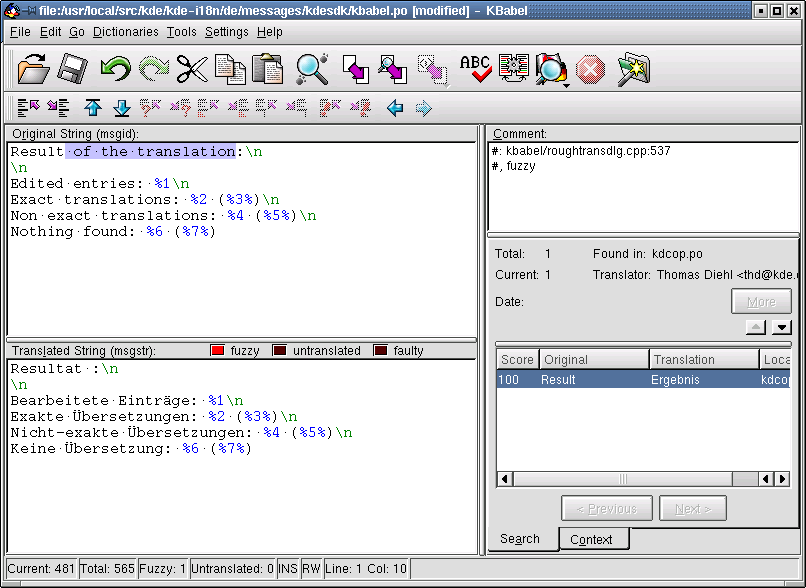
The KBabel main translation screen.
Please click on the image to see the enlarged image.
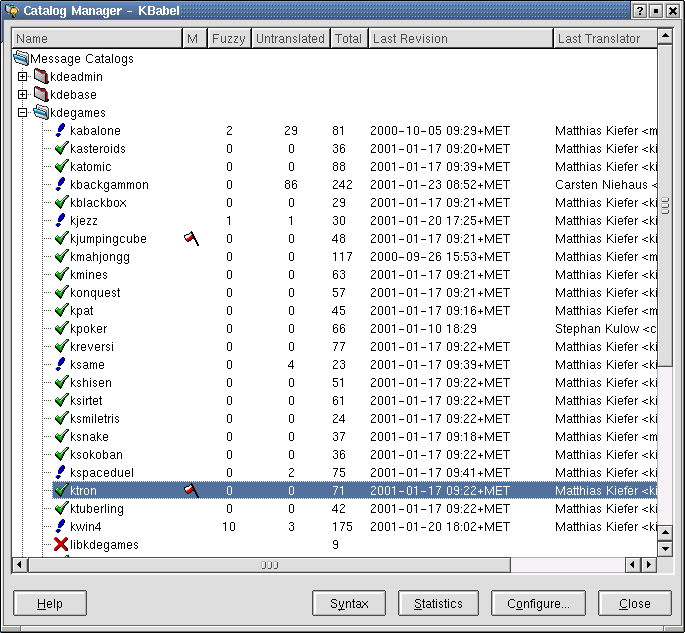
The KBabel Catalog Screen allows keeping up with translation in
large projects.
Please click on the image to see the enlarged image.
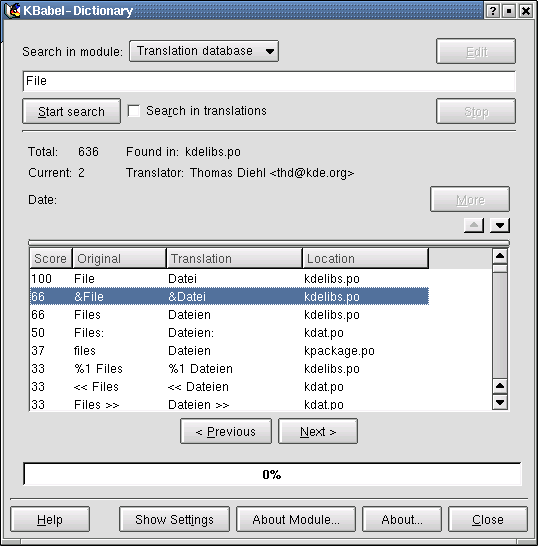
KBabel directory – basic terminology maintenance
Please click on the image to see the enlarged image.
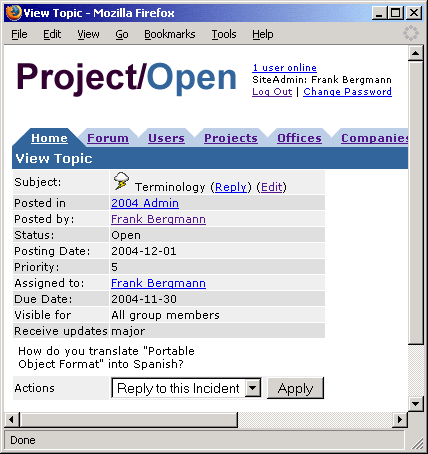
An example screen from ]project-translation[.
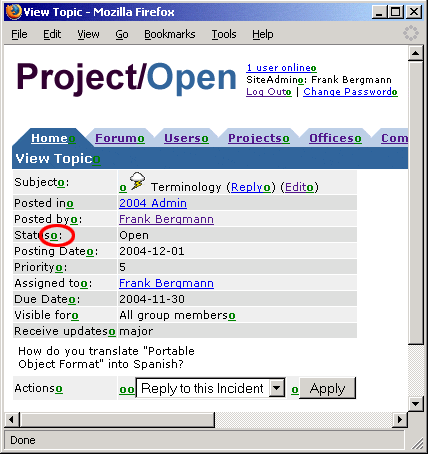
The same screen again, but in translation mode.
Green dots appear behind all translatable strings, allowing the
translator to
work in the linguistic context of the application.
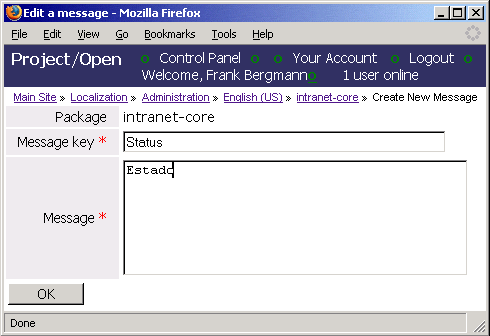
The ]project-open[ translation screen from the example above.

The ]project-open[ catalog screen, showing the list of all translations
in a specific module.
Please click on the image to see the enlarged image.
References & Resources
[1] “A Brief History of Free/Open Source Software Movement”
http://www.openknowledge.org/writing/open-source/scb/brief-open-source-history.html
[2] The GNU Public License
http://www.gnu.org/copyleft/gpl.html
[3] “Open, closed: Novell's 'mixed source' software”
http://star-techcentral.com/tech/story.asp?file=/2004/9/10/technology/8872977&sec=technology
[4] “Governments Mull Open-Source”
http://www.businessempowered.com/issues/2004/03/en/dept_shortcuts.shtml#opensource
[5] Open-Source and Government: The “FLOSS ” Final
Report
http://www.infonomics.nl/FLOSS/report/
[6] European Commission IDA Open Source Observatory
http://europa.eu.int/ida/en/chapter/452
[7] “OpenOffice Localization Pilot Process”
http://l10n.openoffice.org/localization/L10n_pilotprocess.html
[8] Linux Homepage
http://www.linux.org/
[9] The Gettext Localization Suite
http://www.gnu.org/software/gettext/manual/html_mono/gettext.html
[10] KBabel L10N Tool
http://i18n.kde.org/tools/kbabel/
[11] OpenOffice Homepage
http://www.openoffice.org/
[12] OpenOffice L10N Framework (“localize.pl”)
http://l10n.openoffice.org/L10N_Framework/iso_code_build2.html
[13] ]project-open[ Homepage
http://www.project-open.com/
|

